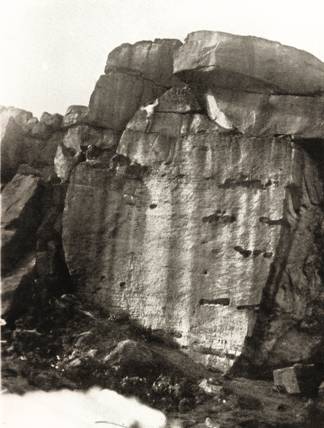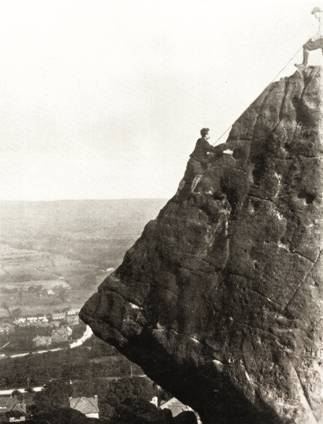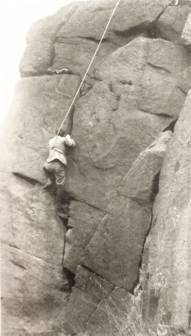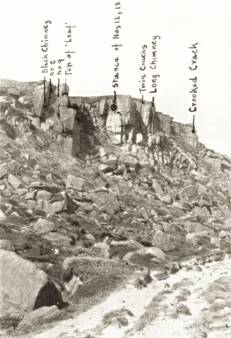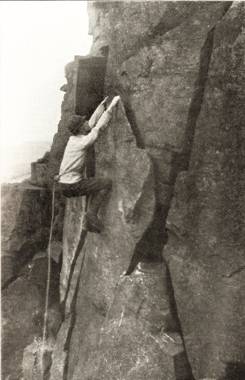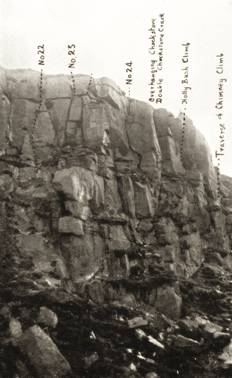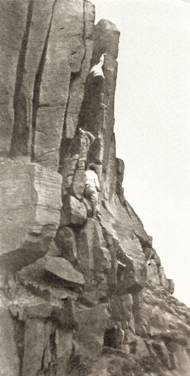Climbing At Ilkley
By W.H. Greenwood.
Leeds is said to have made some name as a centre of the woollen and other trades, but it would appear that the true reasons for its fame lie deeper. Only last year, while in Switzerland, when we mentioned to a Londoner that our home was at Leeds he at once replied: “Oh yes! That’s the place near Almscliffe Crag, isn’t it?” and enviously remarked how fortunate were the people of Leeds in having climbing in their own suburbs. Since it appears that the near presence of Almscliffe Crag is of such importance to Leeds one would think that the presence of rocks at Ilkley would be appreciated to an equal extent, yet, while the rocks of the former are fairly often crowded, those of the latter seldom see two parties climbing on the same day. Why this should be so is not easy to understand, for the Ilkley rocks possess a distinct advantage, as the climbs, being very little scratched, afford good practice in “finding the way,” both to them and on them.
The majority of these climbs are cracks which are ascended by wedging the arm and the leg (usually the left), but there are other varieties, including face climbs, traverses and slabs. For purposes of description they may be divided into two main groups, those on the “Cow and Calf ” and those in the Rocky Valley. The names used to distinguish the climbs are those commonly employed by the frequenters of the rocks, but a large proportion are indicated by numbers only, as they are so infrequently climbed that no name appears to have been given to them.
The Cow:- The best climb of all is one on the ‘Cow’ called the ‘A’ Climb. (Plate I.) The first pitch consists of overhanging rocks on the left and leads to a small platform on which the left-hand figure is standing; the second pitch follows the sloping crack and leads either by a hand traverse to the apex of the ‘A’ which gives the climb its name, or by a walk along the foot of the ‘A’ and up its right-hand side to the apex, which forms a big belay; the third pitch leads to the summit. In the photograph the right-hand figure is standing on the ‘walk’ with hands resting on the traverse. For variety and interest and for a small climb none better could be found anywhere.
To the right of the face containing the ‘A’ Climb is another climb consisting of one good pitch called the ‘A1’ Climb.
The Calf:- On the ‘Calf,’ immediately to the left of the flight of steps carved by a considerate District Council, presumably as a safeguard to climbers, a climb commences up the slab, on which the holds are good, but so small that the temptation to grasp the above-mentioned steps becomes occasionally very great. The descent offers another climb down the left edge of the slab and along a traverse on its foot to the starting-point. (Plate I.)
The Rocky Valley:- The head of the Rocky Valley lies a few minutes’ walk to the S.W. of the ‘ Cow and Calf,’ along a well-marked footpath. The rocks form a line along the far side of the Rocky Valley and are divided into five blocks, which are numbered here consecutively, beginning with the highest.
On Block I. is Climb No. I, or the ‘Little A’ Climb, so named from a resemblance to the shape of one part of the crack on the ‘A’ climb. The first pitch is overhanging and proves quite difficult, as to ascend it calls for a big strain on the arms. This leads to the ‘A,’ which the figure is just entering (Plate II.), and although the exit by the apex is not too easy, there is little likelihood of anyone preferring a return by the crack.
On Block II. are five climbs. The first is No. 2, or the ‘Easy Chimney’ Climb, with a variation finish on the left face, quite possible, but requiring great care.
Next, round the corner, is No. 3, difficult to enter, as it entails much severe arm-pulling. This initial difficulty can be avoided by ascending the slab close by on the right and traversing to the left. (In Plate II., the figure is in the crack, having stepped across from the sloping slab a yard away to his right.)
No. 4 is the climb up this last-mentioned slab, which has convenient holds, and at the top of this are two finishes, to the right and left respectively.
No. 5 is usually called the ‘Fly Paper’ Climb, a name which probably conceals quite a wealth of latent humour, for the climber at least finds it no easy matter to stick on the climb, commencing as it does on an upright wall of rock with small sloping handholds, and both strength and good balance are required to make the first few feet of ascent, after which there is little difficulty.
No. 6, close by, is a well-defined ‘V’ chimney, with not even a suggestion of a hold. We have not heard that it has yet been climbed, and it is offered to those of our readers who hanker after a bonne bouche.
On Block III. the first three climbs, Nos.7, 8 and 9, lie close together. Nos. 8 and 9, well shown in Plate II., lie on either side of a great slab and are easy courses for novices.
No. 7, the ‘Black Chimney’ Climb, commences at the foot of No. 8 and usually provides some amusement. The rock is extremely rough, the chimney invitingly narrow, and to fall out becomes almost as difficult as to progress upwards. By keeping the right leg and shoulder well out, however, the ascent is made much less fatiguing, though the risk of a slip is increased.
The next, No. 10, or the ‘Leaf ‘Climb, commences a little way round the buttress, to the right. The first pitch leads to a cave and the chief difficulty of the climb is to escape from this recess up the left wall, and many will find it a help to use the opposite wall as a foothold. This pitch can be circumvented by ascending a little way to the right up the slab and then traversing to the left over the cave. The next pitch leads over the leaf of rock, which gives the climb its name, into the head of the No. 9 chimney. A good variation finish is made by standing on the top of the leaf and pulling directly up on friction holds.
No. 11, the ‘ Rambling Gully’ Climb, begins by any route up the slab below the cave of the ‘Leaf’ Climb, (the most interesting is on the right of the slab and requires a good pull-up to a flat ledge), and they all lead into a small chimney to reach which requires careful balance.
On Block IV., the first two climbs, Nos. 12 and 13, are of the ‘nightmare ‘ type and perhaps not practicable.
No. 12 consists of a vertical, narrow crack (in shadow in Plate II.) leading by a traverse on the right to a stance overhung by smooth, rounded rocks, the passage of which is risky if not dangerous.
No. 13 begins in a small cave as a wide, deep crack which leads upwards along an airy path to the stance of No. 12. It must be from sheer ill-luck that this airy path has not yet been traversed, for its foot has often been reached, but each time the sight of it has made the leader feel suddenly faint and he has thought it wiser to descend.
No. 14, the ‘Throstle’s Nest’ Climb, a vertical crack, comes next in the corner, a little further to the right. There is a good hold on the left wall and good opportunities of wedging the arm, but the finish is very uncomfortable.
No. 15, the ‘Twin Cracks’ Climb, consists of two narrow, well-marked cracks, of which the one on the left forms the line of ascent whilst the right one affords holds for both hand and foot.
Next comes No. 16, the ‘Long Chimney’ Climb, with an alternative first pitch on the right, a climb full of good holds and in parts seemingly A.P. (See Plate III.)
A little further on is No. 17, a crack which will be improved when someone undertakes to clear away from it a large amount of earth.
Close by on the right is No. 18, or the ‘Crooked Crack’ Climb, which, for almost its whole length, is just the width of a boot. On getting a foothold within it, great trouble is experienced in trying to withdraw again, and the difficulty is emphasized at the curves, which give the climb its name. The finish can be made either directly or by a traverse.
Round the buttress is No. 19, a little climb up a slab and requiring a nice balance.
Block V. is some few minutes’ walk further down the valley and in itself offers enough climbs for a day’s work.
The first, No. 20, or the ‘Dead Tree Chimney’ Climb, appears from a distance easy enough, but closer acquaintance gives a very different impression. The first pitch as far as the dead tree (which is not actually dead but apparently breathing its last) is simple, and so is the next few feet of ascent, but here the chimney narrows so much that one is forced out upon a steep face, offering the most shadowy holds. This difficult bit is not more than a yard in length, but it requires the very greatest care.
No. 21 is an excellent chimney with a crack up its right side. It is strenuous work to ascend by the help of this crack alone, but a long left leg can obtain much assistance from the wall of the chimney.
To reach the next two climbs it is necessary to go round the buttress which flanks No. 21 and ascend up steep grass and broken rocks to the foot of a face much seamed and cracked, some few feet from the left end of which is No. 22, a chimney with two fine pitches. At the top of the second pitch it is necessary to leave the chimney, a proceeding which requires great care, especially if the rocks are wet.
No. 23 is another easier crack to the right, which can be finished either directly or by a traverse.
Round the buttress to the right, a ‘sheepwalk’ leads upwards to No. 24, a chimney with an overhanging first pitch at which a shoulder will afford relief to those who dislike a pull-up on the arms.
Further along appears No. 25, the ‘Overhanging Chockstone’ Climb, with one good pitch, not easy to overcome, unless a good hold well over the chockstone is found.
Only a few feet to the right is No. 26, or the ‘Double Chockstone’ Crack, perpendicular and narrow, but with good holds. The upper of the two thin chockstones is loose, but it appears safe enough if pressure is applied vertically.
Next comes No. 27, or the ‘Holly Bush’ Climb, on which the holly bush affords the only excitement, but the climb offers a short and easy descent from the summit and saves a troublesome walk round the rocks.
The last climb, No. 28, is called the ‘Traverse and Chimney’ Climb and is the most enjoyable course in the Rocky Valley.
It commences low down on a crack sloping to the right and leading to the right of a leaf of rock, which is traversed as shown in Plate III., or by making use of a good foothold rather low down. The difficulty now is to reach the rectangular, flat-topped rock, which shows plainly above the head of the figure, a proceeding easy enough for a high-kicking contortionist, but for others, particularly those of generous build, not at all a simple matter. From the flat-topped rock one steps into the chimney to find that the traverse pitch could have been avoided. The first pitch of the chimney is easy and short, but the second requires firm and careful wedging, as it appears to overhang. The flat ledge of rock on the right offers a safe handhold, which forms the key of the pitch.
The climbs here described are generally of about thirty-five feet in length, though some, such as the ‘A’ Climb, the Long Chimney and the Traverse and Chimney, approach sixty feet. All of them can be attempted as legitimate climbs, with the possible exception of Nos. 6, 12, 13 and 14, and only on these has the writer not led throughout. It is probable that other climbs can be made in the Rocky Valley and the Editor will be interested to hear of any that are worthy of being added to the above list.
